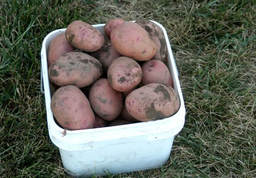 Potatoes are ready to harvest when the vines are about half dead. Potatoes dug too early have tender skins and are easily bruised. Delaying digging will allow the soil to heat since it is no longer shaded by foliage. High soil temperatures can lead to sprouting potatoes. Allow potatoes to "set" by keeping them in a shady, dry location for three to four days. Then move them to a cool, moist environment such as a cellar or cool basement for longer storage. (Ward Upham) 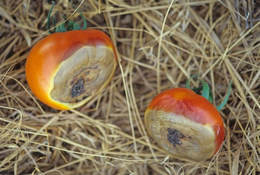 If you have tomatoes with a sunken, brown leathery patch on the bottom of the fruit, you probably have blossom end rot. Though most common on tomatoes, blossom end rot can also affect squash, peppers and watermelons. Not a disease, this condition is caused by a lack of calcium in the developing fruit. It is often assumed that this means there is a corresponding lack of calcium in the soil. This is not necessarily the case, especially in Kansas. Most Kansas soils are derived from limestone, which is partially made up of calcium. So, what causes blossom end rot? Actually, there are a number of possible causes, especially on tomatoes. Let's look at some of them. - Tomato tops often outgrow the root system during cooler spring weather. As long as it is cool, the root system can keep up. When it turns hot and dry, the plant has a problem, and water — with the calcium it carries — goes to the leaves and the fruit is bypassed. The plant responds with new root growth and the condition corrects itself after a couple of weeks. - Heavy fertilization, especially with ammonium forms of nitrogen, can encourage this condition. Heavy fertilization encourages more top than root growth and the ammonium form of nitrogen competes with calcium for uptake. If blossom-end rot has been a perpetual problem, try using calcium nitrate (15-0-0) as your fertilizer. - Anything that disturbs roots such as hoeing too deep can encourage blossom-end rot. Mulching helps because it keeps the soil surface cooler and therefore a better environment for root growth. - Inconsistent watering can be a factor. Keep soil moist but not waterlogged. Mulching can help by moderating moisture levels over time. You should also avoid damaging roots and watch fertilization. But there are some years you do everything right and the condition shows up due to the weather. In such cases, remember that blossom-end rot is usually a temporary condition, and plants should come out of it in a couple of weeks. You may want to pick off affected fruit to encourage new fruit formation. Soils with adequate calcium will not benefit from adding additional calcium. If your soil is deficient in this nutrient, add 1 pound gypsum per 100 square feet. Gypsum is calcium sulfate and will not affect pH. Though calcium raises pH, sulfate lowers it and the two cancel each other out. Even if not needed, gypsum will not hurt anything. We have also found that spraying plants with calcium doesn't work. The fruit's waxy surface doesn't allow absorption of the material and calcium does not move from the leaves to the fruit. (Ward Upham) 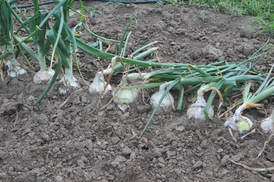 Onions are ready to harvest when about half the plants have tops that have fallen over. This is a sign that the onions are mature and need to be pulled out of the ground. Bulbs may sunburn without the foliage to protect them. The secret to onions keeping well is to allow the tops to dry completely before storage. Move onions to a shaded, well-ventilated area after harvest. After tops are completely dry, store in a cool, dry location. Large-necked onions take more time to dry than small-necked onions such as Bermuda types. Avoid storage in plastic bags because the lack of air circulation will shorten storage life. Use an open, mesh bag instead. (Ward Upham) If you have vegetables that are blooming but not setting fruit, you may have a problem with flower pollination. There are several possible reasons for this that usually vary by species. One condition that can affect several species at the same time is overfertilization. Too much nitrogen causes the plant to emphasize vegetative growth, often to the detriment of fruit production. Overfertilization can lead to a delay in flower production and a decrease in fruit set among the flowers produced.
Squash, cucumbers, watermelon, and muskmelon can have a couple of other problems. First, the early flowers on these plants are usually all male. The production of both male and female flowers becomes more balanced as time passes. You can easily tell the difference between the two because only the female flower has a tiny fruit behind the blossom. If you have both, have not over-fertilized, and still have a problem, make sure you have pollinators. Look for the presence of bees visiting the plants. If you don't see any, try hand-pollinating several flowers. Use a painter’s brush to transfer pollen from the anther of the male flower to the stigma of the female flower. If you get fruit on only those flowers you pollinated, you need more pollinators. Make sure you aren't killing them with overuse of insecticides. If you must use an insecticide, spray near dusk when the flowers have closed. Tomatoes are wind pollinated and therefore not dependent on pollinators. But they have another possible problem which is temperature. Tomatoes normally won't set if the night temperature is below 50 due to sparse pollen production. They also won't set when nighttime temperatures are above 75 degrees F and daytime temperatures are above 95 degrees F with dry, hot winds. Under such conditions, fertilization is not completed and no fruit develops. (Ward Upham) 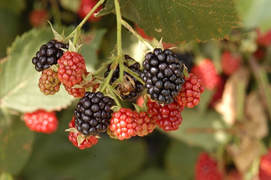 The exact time to harvest blackberries varies by cultivar, with thorny blackberries normally ripening earlier than thornless types. But there are some general guidelines to keep in mind when harvesting blackberries. Do not pick blackberries too early or berry size and flavor will be sacrificed. Two major characteristics determining maturity for harvest are fruit color and ease of separation. Blackberries usually develop a dull, black color with plump, juicy fruitlets as they ripen. The berries soften and produce the characteristic blackberry flavor. Full color often develops before the berries separate easily. Pick the berries by gently lifting with the thumb and fingers. The receptacle, or center part of the fruit, remains in the fruit when blackberries are harvested, unlike raspberries, which leave the receptacle on the bush. Take care not to crush the berries or expose them to the hot sun. When possible, avoid picking berries when they are wet. They'll likely need picking every second or third day. Cool the berries immediately after harvest to extend shelf life. Keep them refrigerated under high relative humidity and use within three to five days. (Ward Upham) 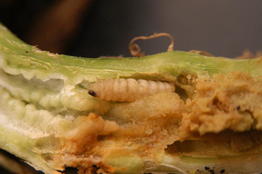 If you have squash or related plants that suddenly wilt and die, you may have squash vine borer. This insect will bore into the stems of squash, zucchini, pumpkins and gourds. Hubbard squash are a favorite, and butternuts are less likely to be attacked than other squash. Cucumbers and melons are usually not a target, although both can be affected by a disease that causes similar symptoms, known as bacterial wilt. The adult of this insect is a clear-winged moth that resembles a wasp. The forewings are a dark metallic green but the rear wings are clear. The abdomen is orange with black spots. The larva is cream-colored and rather wrinkled. Adults emerge in the spring and lay eggs on or near susceptible plants. Larva bore into the plant and feed for about a month as they move toward the base. Mature larva will exit the plant, burrow into the soil and pupate where they remain until the next year. Each plant can have numerous borers. If you suspect squash vine borer, split the stem of a collapsed plant near where it enters the ground. Infested plants will be hollowed out and mushy and may contain borers. Unfortunately, there isn't much you can do at this late stage. Control measures should center on prevention. Suggested preventative controls would include crushing the dull red eggs before they hatch, excavating larvae from stems before they cause much damage or using insecticide applications. Applications should begin when the vines begin to run (too late for that) and reapplied every seven to 10 days for three to five weeks. Direct the spray at the crown of the plant and the base of runners. Chemicals used for borer control in gardens are permethrin (Bug-No-More Yard & Garden Insect Spray; Eight Vegetable, Fruit & Flower Concentrate; Lawn, Garden, Pet and Livestock Insect Control; Lawn & Garden Insect Killer) or bifenthrin (Hi-Yield Bug Blaster II, Bug-B-Gon Max Garden Insect Killer) applied as sprays or dusts. Continue on a 7 to 10 day reapplication schedule for 3 to 5 weeks. If plants wilt, look for the presence of holes and ooze. However, in extreme heat, these plants will wilt in the afternoon even if undamaged by this insect. (Ward Upham) 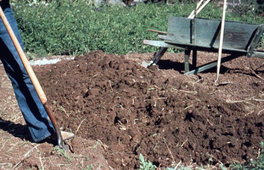 Soil texture is simply a way to define the combination of the 3 types of soil particles: sand, silt, and clay. Did you know that the amount of each type of particle in your soil is important for both plant and soil health? "Building Better Soils for Better Crops" states that each type of soil particle has a different range of size: sand (0.05-2.0 mm), silt (0.002-0.05mm), and clay (less than 0.002mm). These particles are the building blocks of the soil skeleton. Clay has the smallest amount of space between particles, feeling smooth and sticking together, while sand has the largest amount of space between particles, feeling gritty and not sticking together. A soil test can tell you what your soil texture is, but you can determine your soil's texture at home by grabbing a handful of soil and adding a little water. This method is called ribboning or texture by feel. To learn how the ribboning technique works, follow this link, https://bit.ly/2I1bE7D, to the K-State Research and Extension publication written by the Department of Agronomy. You can also watch this video, https://bit.ly/2K1HOSi, provided by K-State Research and Extension and featuring Dr. DeAnn Presley. Next week we will cover how soil particle and pore size impacts water infiltration, soil aeration, and the health of your plants. For more information follow this link, https://bit.ly/2M9x1GH, to the "Building Better Soils for Better Crops" chapter called Soil Particles, Water, and Air. (Chandler Day) 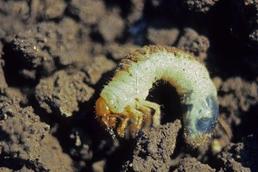 If you plan on using a grub preventative on your lawn, the first half of July is a good target date for most products. Preventatives are normally used on areas that have had a history of grub problems. Traditional grub insecticides such as Dylox or carbaryl (Sevin) are normally applied in late July after grubs are present or as a rescue treatment once damage is seen. Products that contain Merit (imidacloprid) are considered grub preventers. Actually, these products do not prevent grubs, but rather kill grubs when they are quite small, and long before they cause damage. Merit is safer to use around pets and humans than traditional grub killers. Merit can be found in Bayer's Season-Long Grub Control, Bonide Grub Beater, Gordon’s Grub No-More and Hi-Yield Grub Free Zone. Another grub preventer with the trade name GrubEx contains chlorantraniliprole. Though this product is very effective, it is less water soluble than imidacloprid. It should be applied earlier, preferably April or May, but applications through June should still be effective. Remember, all grub products should be watered in soon after application. (Ward Upham) |
AuthorsCynthia Domenghini runs the Horticulture Response Center in the Department of Horticulture and Natural Resources at Kansas State University. Other contributors include K-State Extension Specialists. Archives
March 2024
Categories
All
|
| K-State Research and Extension Horticulture Newsletter |
|
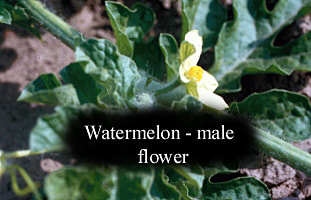
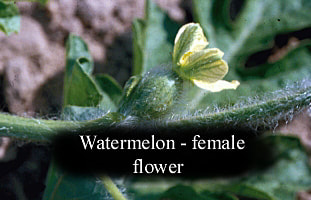
 RSS Feed
RSS Feed
